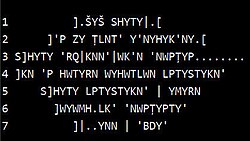அசோகரின் காந்தார அரமேயம் கல்வெட்டு
 அரமேய மொழிக் கல்வெட்டுக் குறிப்புகள் ரோமன் எழுத்தில் எழுத்துப்பெயர்ப்பு | |
| செய்பொருள் | கருப்பு நிற சுண்ணாம்புக் கல் |
|---|---|
| எழுத்து | அரமேயம் |
| உருவாக்கம் | ஏறத்தாழ கிமு 260 |
| காலம்/பண்பாடு | 3ஆம் நூற்றாண்டு |
| இடம் | பழைய காந்தாரம், ஆப்கானித்தான் |
| தற்போதைய இடம் | பழைய காந்தாரம், ஆப்கானித்தான் |

அசோகரின் காந்தார அரமேயம் கல்வெட்டு (Aramaic inscription of Kandahar) பேரரசர் அசோகர் தனது மௌரியப் பேரரசின் பகுதியான தற்கால ஆப்கானித்தான் நாட்டின் காந்தாரப் பகுதியில் அரமேய மொழியில் கிமு 260-இல் கல்வெட்டை நிறுவினார். 24x18 செண்டிமீட்டர் அளவுள்ள இக்கல்வெட்டு கருப்பு நிற சுண்ணாம்புக் கல்லால் ஆனது.
அசோகரின் காந்தார கிரேக்க மொழிக் கல்வெட்டை கண்டுபிடித்த அதே ஆண்டான 1963-இல் அசோகரின் இந்த அரமேய மொழிக் கல்வெட்டை பழைய காந்தார நகரத் தொல்ல்யல் களத்தில் ஆண்டூரு டூபாண்ட் சோம்மர் கண்டிபிடித்தார். [1][2]

கல்வெட்டின் உள்ளடக்கம்
[தொகு]அசோகரின் பெரிய தூண் கல்வெட்டுக்கள் வகையில் சேர்ந்த அரமேய மொழிக் கல்வெட்டு ஆகும். [3][4] n°7-இலிருந்து ஒரு பத்தியின் பதிப்பாக விளக்கப்படுகிறது.[5] இந்த அராமிக் மொழி கல்வெட்டில் பல முறை காணப்படும் SHYTY என்ற சொல் மத்திய இந்திய சொல்லான Sahite உடன் ஒத்துள்ளது. இந்தக் கல்வெட்டு, அதன் பகுதியளவு மற்றும் பெரும்பாலும் தெளிவற்ற தன்மையைக் கொண்டிருந்தாலும், வரிக்கு வரி வர்ணனையாகவோ காணப்படுகிறது.[2] A புகைப்படங்களுடன் கூடிய விரிவான பகுப்பாய்வை ஆசியாடிக் ஜர்னலில் வெளியிடப்பட்டது.[6]
இதனையும் காண்க
[தொகு]- அசோகர் கல்வெட்டுக்களின் பட்டியல்
- அசோகரின் பெரிய தூண் கல்வெட்டுக்கள்
- அசோகரின் சிறு தூண் கல்வெட்டுகள்
- அசோகரின் பெரும் பாறைக் கல்வெட்டுக்கள்
- அசோகரின் சிறு பாறைக் கல்வெட்டுக்கள்
மேற்கோள்கள்
[தொகு]- ↑ A new Aramaic inscription of Asoka found in the Laghman Valley (Afghanistan), André Dupont-Sommer Proceedings of the Academy of Inscriptions and Belles-Lettres Year 1970 114-1 p.173
- ↑ 2.0 2.1 A new Aramaic inscription of Asoka discovered in Kandahar (Afghanistan) Dupont-Sommer, André Records of the sessions of the Academy of Inscriptions and Belles-Lettres Year 1966 110-3 pp.440-451
- ↑ Handbuch der Orientalistik by Kurt A. Behrendt p.39
- ↑ "A third fragment found in Kandahar (Kandahar III) is a passage from the seventh pillar edict of which the text of Origin in Mgadh is translated into groups of words in Aramaic "Session Reports - Academy of Inscriptions & belles-lettres 2007, p.1400
- ↑ Handbuch der Orientalistik by Kurt A. Behrendt =PA39 p.39
- ↑ "An Indo-Aramaic Inscription of Asoka from Kandahar", Emil Benveniste and André Dupont-Sommer, Journal Asiatique, T. ccliv 1966, pp.437-465.
ஆப்கானித்தான் தலைப்புகள் | |
|---|---|
| தலைநகரம் | |
| புவியியல் | |
| வரலாறு |
|
| நகரங்கள் | |
| மாகாணங்கள் | |
| மக்கள் & மொழிகள் |
|
| பண்பாடு & தொல்லியல் |
|
| அரசியல் |
|
| பொருளாதாரம் |
|
Text is available under the CC BY-SA 4.0 license; additional terms may apply.
Images, videos and audio are available under their respective licenses.

